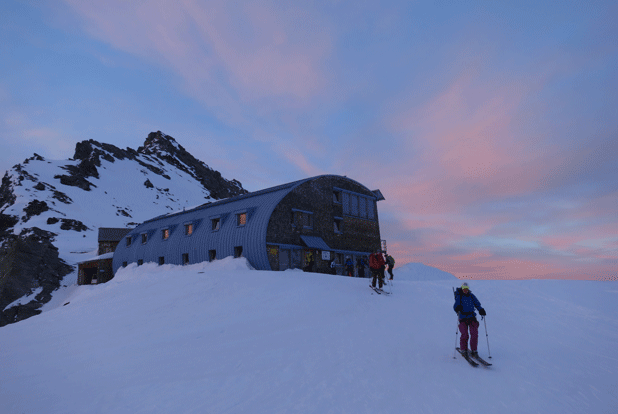Multiday Ski Traverse Packlist
SKI SET UP
O Alpine Touring skis with touring bindings and skins or
O Telemark skis with Tele-binding and skins
O Poles
O AT or Tele Boots
SKI MOUNTAINEERING GEAR
O Ski crampons – must fit bindings and ski width
O Boot crampons – a ski-boot specific crampon made with light alloy is best
O Ice Axe (50-60m) – ultra light is best
O Light ski harness
O 2 locking screw-gate carabiners, 24” sewn sling, webbing 1,5 m, 5-6 mm (for short Prusik), webbing ca. 2,5 m, 5-6 mm (for long Prusik)
O 1 Ice screw
O Ski or Climbing Helmet. Climbing helmets are often lighter.
SNOW SAFETY GEAR
O Avalanche Transceiver (457 kHz), less than 5 years old with fresh batteries as well as spare batteries
O Probe
O Shovel
Pack
O Ski pack (35-40 liter) with a strap system to carry skis (e.g. 35L Patagonia Ascensionist Backpack)
O Plastic bag for wet clothes
CLOTHING
Next to skin layers:
O Short sleeve T-shirts (2 pr.) – light merino wool or Capilene
O Long sleeve light merino wool or Capilene or zip t-neck
O Merino wool or capilene briefs (2-3 pr.)
O Merino wool or capilene light long johns
O Ski socks (2 pr.)– wool or synthetic
Outer layers:
O Fleece pullover or full zip (ideally Patagonia Piton Hybrid Hoody)
O Soft-shell mountain pants (Patagonia “Guide Pants” or similar – synthetic stretch woven fabric)
O Puff jacket, nylon with synthetic insulation ( e.g. Nano-Puff Jacket) or a Down jacket (e.g. Down Sweater Full-Zip Hoody)
O Light alpine wind shirt (e.g. Alpine Houdini) or
O Light outer water resistant jacket (e.g. M10 or Super Cell jacket)
O Light wool hat
O Light neck gaiter (Buff or fleece)
O Sun hat – with visor
O Gloves – Medium weight, warm ski gloves and light gloves for spring conditions
O Bandana
MISCELLANEOUS
O 1-Liter water container or hydration system or large thermos
O 1⁄2 liter steel thermos (optional, but strongly recommended)
O Sunglasses with side protection
O Goggles with light lenses for storm conditions
O Sunscreen – 50+ SPF (small amount dispensed in squeeze bottle)
O Lip balm – 50+ SPF
O Small personal first aid kit – Moleskin tape (protective heel applications recommended, e.g. Compeed Blister Plasters),
O Bandaids, aspirin, personal meds
O Small toilet kit – toothbrush, toothpaste, etc.
O Light headlamp with fresh, long lasting batteries. Extra batteries are usually available for purchase at huts
O Camera, with charger or extra batteries
O Small pocket knife
O Ear plugs
O Ultra light hut sleeping bag (required at all huts e.g. Meru Mummie)
O Alpine Club membership card
O Rescue Insurance information
O Cash and Credit Card
TRAVEL NEEDS
O Ski Bag – Medium zippered duffel bag with pad lock
O Clothing and footwear appropriate for spring continental travel
O Passport and Passport pouch
O Credit Card
FOOD DURING THE TOUR
At all the huts and lodges you will get complimentary hot tea. Other drinks including beer, wine or additional water may be purchased individually.
Lunch Food: Skiing food, bars or sandwiches will be available for purchase at the lodges. At some huts the lunch food is complementary, but not at all.
Some people my wish to bring certain products they are familiar with from home such as energy bars. We request each person calculate their lunch food carefully for the amount they will need as this can add a lot of weight. High carbohydrate and caloric value are recommended.

